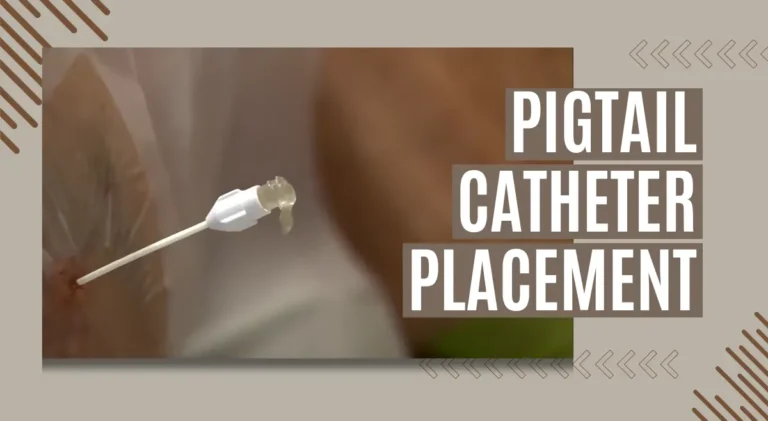
Introduction
Pigtail catheter placement is a common interventional radiology procedure used for various therapeutic and diagnostic purposes. This comprehensive guide explores the indications, technique, patient preparation, potential complications, and post-procedure care associated with pigtail catheter placement.
Table of Contents
Indications
Pigtail catheters are utilized in a wide range of clinical scenarios, including:
- Drainage of pleural or peritoneal effusions
- Management of ascites or hydrothorax
- Nephrostomy for urinary drainage
- Abscess drainage
- Hemostasis following percutaneous procedures
- Contrast injection during angiography or cholangiography
Technique for Pigtail Catheter Placement
Pigtail catheter placement involves several key steps:
- Patient Preparation::
- Proper patient positioning and sterile draping of the target area..
- Image Guidance::
- Utilization of fluoroscopy, ultrasound, or CT guidance to identify the optimal entry site and trajectory for catheter placement.
- Local Anesthesia::
- Administration of local anesthesia to minimize discomfort at the entry site.
- Needle Insertion::
- Insertion of a hollow needle through the skin and into the target structure under imaging guidance.
- Guidewire Placement::
- Advancement of a guidewire through the needle into the desired location.
- Catheter Insertion::
- Introduction of the pigtail catheter over the guidewire into the target structure.
- Confirmation::
- Verification of correct catheter placement using imaging modalities.
- Securement::
- Securing the catheter to the skin to prevent displacement.
Patient Preparation
Prior to pigtail catheter placement, patients undergo a thorough evaluation, including a medical history review, a physical examination, and imaging studies. They may be instructed to fast for a specified period before the procedure and may require laboratory tests to assess their coagulation status. Informed consent is obtained, and patients are educated about the procedure, potential risks, and expected outcomes.
Types of Pigtail Catheters
- Nephrostomy Pigtail Catheters:
- Specifically designed for percutaneous renal drainage.
- Used to divert urine from the kidney when the normal flow to the bladder is obstructed.
- Commonly used in cases of kidney stones, strictures, or malignancies.
- Pleural Drainage Pigtail Catheters:
- Used for draining fluid or air from the pleural space in conditions like pleural effusion or pneumothorax.
- The pigtail configuration helps secure the catheter within the pleural cavity.
- Ureteral Pigtail Catheters:
- Inserted into the ureter for drainage or as a conduit for performing endourological procedures.
- Can be used for long-term stenting in cases of ureteral obstruction.
- Biliary Drainage Pigtail Catheters:
- Placed within the biliary system to drain bile in cases of obstruction due to stones, strictures, or tumors.
- Helps alleviate symptoms of jaundice and cholangitis.
- Abscess Drainage Pigtail Catheters:
- Utilized for percutaneous drainage of abscesses in various body regions such as the abdomen or pelvis.
- Minimally invasive alternative to surgical drainage.
- Cardiovascular Pigtail Catheters:
- Used in cardiac catheterization procedures to inject contrast dye or measure pressures within the heart chambers.
- The pigtail shape prevents damage to the cardiac walls.
- Multipurpose Drainage Pigtail Catheters:
- Versatile catheters that can be used in various anatomical locations for drainage.
- Often have a hydrophilic coating for easier insertion and patient comfort.
Complications
While pigtail catheter placement is generally safe, it carries a risk of complications, including:
- Bleeding: Hemorrhage at the puncture site or along the catheter tract.
- Infection: Risk of infection at the insertion site or within the target structure.
- Pneumothorax: Development of a collapsed lung, particularly in pleural procedures.
- Catheter Dislodgement: Accidental displacement or migration of the catheter.
- Organ Injury: Damage to adjacent structures during needle insertion or catheter placement.
Post-Procedure Care
- Following pigtail catheter placement, patients require close monitoring for any signs of complications, such as bleeding, infection, or catheter dysfunction. Catheters may be connected to drainage bags or collection systems as needed, and drainage output is monitored regularly. Patients receive instructions on catheter care, wound management, and activity restrictions to promote optimal healing and minimize the risk of complications.
Conclusion
Pigtail catheter placement is a valuable interventional radiology procedure with diverse applications in clinical practice. By understanding the indications, technique, patient preparation, potential complications, and post-procedure care associated with pigtail catheter placement, healthcare providers can ensure safe and effective patient management. Collaboration between interventional radiologists, referring physicians, and multidisciplinary teams is essential to optimize outcomes and improve patient satisfaction.
Commonly Asked Questions about "Pigtail Catheter Placement"
- Pigtail catheters are used to drain fluids, deliver medications, aid in diagnostic procedures, and facilitate therapeutic interventions in various medical conditions.
- Pigtail catheters are smaller, flexible tubes primarily used for drainage in less severe cases, while chest tubes are larger, rigid tubes employed for draining larger volumes of fluid or air from the chest cavity in more serious conditions such as pneumothorax or hemothorax.
- Pigtail drains are primarily used for draining fluids from the body, such as pleural effusions or ascites, and for delivering medications or contrast agents directly to specific sites for treatment or diagnostic purposes.
- Complications of a pigtail catheter may include bleeding, infection, pneumothorax (if placed in the chest), catheter dislodgement, or organ injury, though they are relatively rare when the procedure is performed correctly.
- The procedure is typically performed under local anesthesia to minimize discomfort. Patients may experience mild discomfort or pressure during needle insertion and catheter placement, but the procedure is generally well-tolerated.
- The duration of catheter placement varies depending on the underlying condition being treated and the patient’s response to therapy. In some cases, the catheter may be removed once drainage resolves, while in others, it may be left in place for longer-term management.
- After the procedure, patients may experience mild discomfort or pain at the insertion site, which can be managed with over-the-counter pain medication. They will receive instructions on catheter care, wound management, and activity restrictions to promote optimal healing.
- Yes, pigtail catheters can be used for long-term drainage in certain clinical scenarios, such as chronic pleural effusions or ascites. However, close monitoring and regular catheter care are essential to prevent complications and ensure continued effectiveness.



